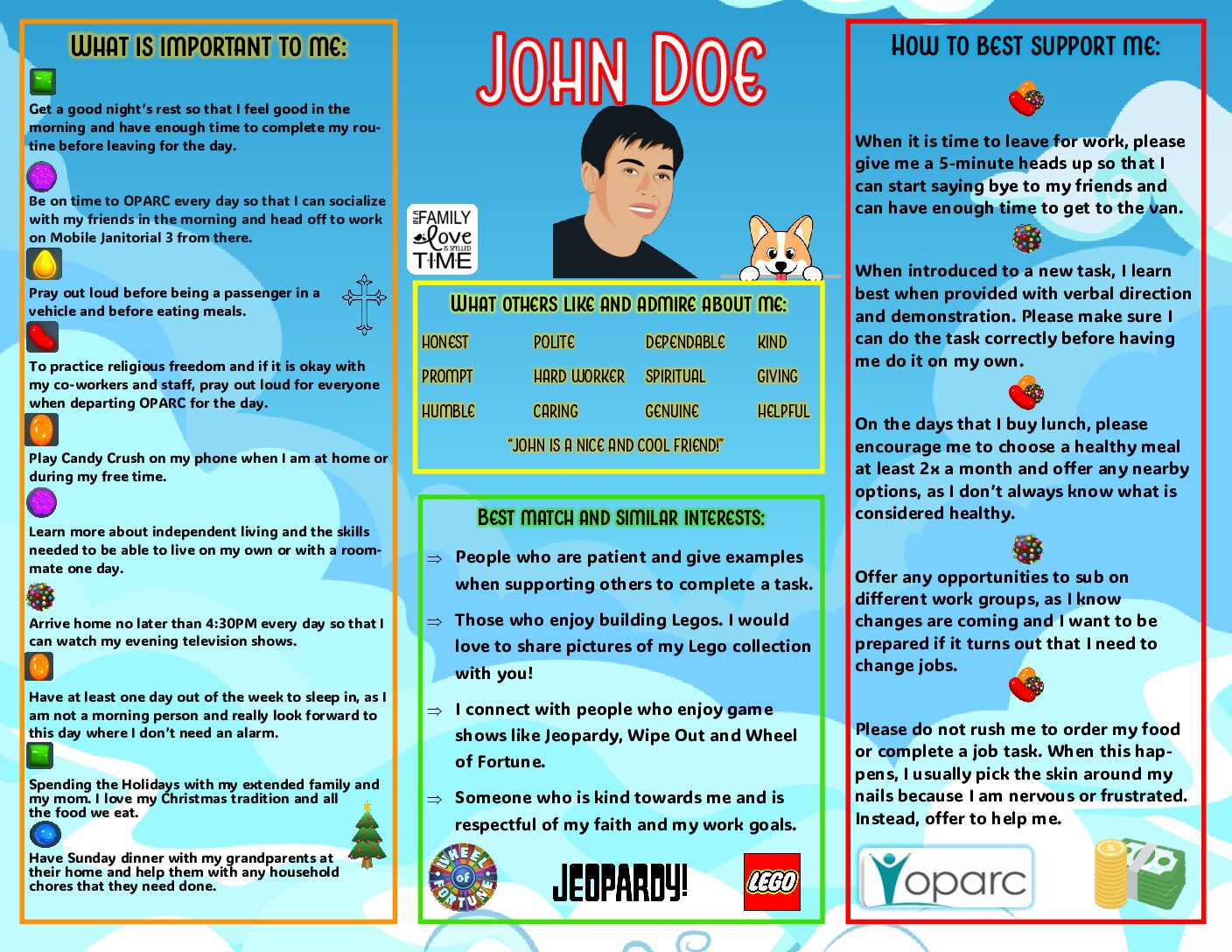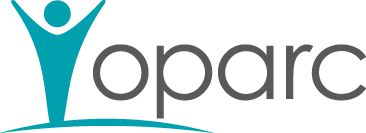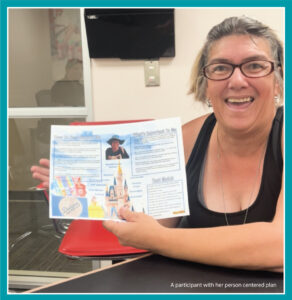
PERSON CENTER PLANNING
Above is an example of a one page description of a participant “John Doe” after a Person Centered Plan has been completed. This page is a valuable tool for the participant (focus person) as well as all others who need to know how to best support him/her.
OPARC takes a person-centered thinking approach that offers flexible development programs designed to teach life, social and employment skills. Every OPARC participant is matched with a team of support professionals who advocate to help them identify and set their individual goals. A realistic plan is developed that confirms objectives to realize their goals, progress points and milestones. It is reviewed and finalized with approval from the participant.
Relationship Map
The Relationship Map creates a picture of who is in the focus persons life, as well as their role and importance. It captures who a person knows, how they know them, who else in their circle knows them and how these networks and relationships can help a person to live the life they choose. This mapping feeds into support planning because it highlights those people who should be involved in planning and helps to discover which relationships can be strengthened and supported.
Like and Admire
This tool puts into perspective what people truly like and admire about the focus person, as well as what they like and admire about themselves. This section should include multiple perspectives from everyone in this person’s support team.
Example: Mother Sue – “I have always admired how John is just a very genuine and honest person. He has a good heart and is very giving and humble. I have always admired how kind he is and how he would do anything for anyone, just very caring. He is also creative; he enjoys building his Legos and is really skilled.”
Rituals and Routines
Rituals guide us through our days and bring consistency, comfort, and control. We create rituals or a way of going about our routines for many things. A good routine to start with is a morning ritual. We assist the focus person in writing down their morning rituals and routines.
Example: Alarm rings at 5:30AM. Usually snoozes alarm once or twice before actually getting up. “I’m not a morning person”. In the shower by 6AM, uses hot water, but showers quickly to leave enough hot water for mom. Brushes teeth, combs hair, and dresses in clothes that mom picked out the night before (Usually blue jeans and a printed t-shirt). Goes downstairs for breakfast by 6:30AM. “I like a big breakfast every morning. Mom makes whatever I want, which is usually pancakes, scrambled eggs, country potatoes, bacon, sausage or biscuits. Always with orange juice.”
Good Day/Bad Day
This tool helps to sort out and understand the important aspects of the focus person’s day to day living. It helps with understanding what is important to and for the person, to have the life that they want. We ask the person to think about their best day and then think about a bad day. What are the things that make you feel good? What are the things that are difficult for you? By looking at a bad day, this doesn’t necessarily mean there are things on there that we can fix; but it gives us information that we can look at to see if we can put actions into place to make the person have more good days than bad.
4 + 1 Questions
This tool is used when working with anyone who is earning sub-minimum wage, as well as on an individualized basis for all other program participants. The 4 + 1 questions tool is powerful when used to look at a particular aspect of someone’s life. It helps the focus person learn from their efforts and focus on next steps. It is used to evaluate a specific process and plan next steps.
It focuses discussion on four main questions:
What have we tried?
What have we learned?
What are we pleased about?
What are we concerned about?
These questions lead to the “plus 1”:
What do we need to do next?
Important TO & Important FOR Sort
This is a way to organize the information that is collected when using other tools and provided through meaningful conversation. By sorting what is learned, a deeper understanding of the person is gained, while working towards a good balance. Perspectives from the family or other members of the support team are welcomed and should be noted.
Communication Chart
This tool is used to record how people communicate, prevent information loss during staff turnover, give new people a quick reference guide, and reduce the need for behavior plans that arise from people not being listened to. It helps staff and support team understand what a person in trying to tell us and what those who support the person need to do in response. It is useful both with people who are very articulate as well as for all people who do not communicate with words.
Example:
When This Happens:
I am told that we are behind schedule
I Do This:
Don’t say very much and rush through my tasks
It Usually Means:
I am overwhelmed or feel like I am in trouble
And I Want You To:
Tell me that it is okay and offer to help me complete tasks so I won’t feel overwhelmed
Matching
Matching provides a structure to look at important “people characteristics” that the focus person desires in his or her support staff. Interests, as well as what skills and supports make for good matches are also detailed in this skill.
Matching helps managers and supervisors to identify staff and potential employees that are likely to work best with people served. It also identifies shared interests and personality characteristics that the focus person would like to have in common with their match.
Decision Making Profile
The Decision Making Profile creates a clear picture about how a person makes a decision and how they want to be supported in decision-making. It can be used alongside the decision-making agreement to help people to have a choice and control in their lives.
It is broken down into five categories
How I like to get information
How to present choices to me
Ways you can help me understand
When is the best time for me to make decisions?
When is it a bad time for me to make a decision?
Important To & How to Best Support
Now that information regarding what is important TO and what is important FOR the focus person has been gathered, sorted, and analyzed a foundation is established. This foundation consists of “the balanced” outcome of what is important To and For the focus person, as well as what others need to know to best support him/her.
This information is then used to create the One Page Description.
Other Things to Still Figure Out
How do I want my life to be?
What do I bring? (Skills, Resources, Connections)
What are my hopes and dreams
What do I want to change in my life
What are my places and community
What are our ideas?
You Can Make a Difference
First established in 1950, OPARC offers trusted programs to individuals with I/DD.
OPARC has been championing and advocating for diversity, equality, and inclusion for Adults with I/DD. We’re committed to supporting individuals in our various programs and empowering them to reach their full potential. Let’s continue to work together towards a brighter, more equitable future for all.
Thank you

